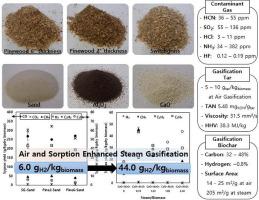当前位置:
X-MOL 学术
›
Energy Convers. Manag.
›
论文详情
Our official English website, www.x-mol.net, welcomes your feedback! (Note: you will need to create a separate account there.)
Enriched hydrogen production over air and air-steam fluidized bed gasification in a bubbling fluidized bed reactor with CaO: Effects of biomass and bed material catalyst
Energy Conversion and Management ( IF 10.4 ) Pub Date : 2020-12-01 , DOI: 10.1016/j.enconman.2020.113408 Hyungseok Nam , Shuang Wang , K.C. Sanjeev , Myung Won Seo , Sushil Adhikari , Rajdeep Shakya , Doyeon Lee , Saravanan R Shanmugam
Energy Conversion and Management ( IF 10.4 ) Pub Date : 2020-12-01 , DOI: 10.1016/j.enconman.2020.113408 Hyungseok Nam , Shuang Wang , K.C. Sanjeev , Myung Won Seo , Sushil Adhikari , Rajdeep Shakya , Doyeon Lee , Saravanan R Shanmugam

|
Abstract Gasification is one of the methods of generating biopower or biofuels from biomass waste. In this study, a bench-scale fluidized bed reactor was used for biomass air and air-steam gasification. Gasification was performed under constant operating conditions (~780 °C, equivalence ratio = ~0.32) to investigate the effect of biomass (switchgrass, pine residues) and bed materials (sand, CaO+ sand, Al2O3, and CaO + Al2O3). All gasification products, such as synthesis gas (syngas), contaminant gases, tar, and biochar (solid) were comprehensively analyzed. The composition of biomass significantly impacted CO and H2 yield from volatile combustible matter and fixed carbon. Further, the presence of CaO made the condition favorable for the water-gas shift (WGS) reaction combined with the CO2 carbonation reaction, which increased H2 concentration. Additional steam with CaO increased H2 concentration closer to 50% (N2 free condition) through the combination reactions of steam hydrocarbon reforming and WGS by producing 44 gH2/kgdry biomass and 143 gCO/kgdry biomass. The usage of steam reduced the overall yield of contaminant gases, whereas the usage of CaO or Al2O3 decreased the amount of gasification tar by approximately 5.8–6.5 gtar/kgdry biomass. This study can provide valuable experimental data for biomass waste to produce better quality syngas.
中文翻译:

CaO鼓泡流化床反应器空气和空气蒸汽流化床气化富氢制氢:生物质和床料催化剂的影响
摘要 气化是利用生物质废弃物生产生物动力或生物燃料的方法之一。在这项研究中,一个台式流化床反应器用于生物质空气和空气蒸汽气化。在恒定操作条件下(~780 °C,当量比 = ~0.32)进行气化,以研究生物质(柳枝稷、松树残渣)和床层材料(沙子、CaO+ 沙子、Al2O3 和 CaO+Al2O3)的影响。综合分析了所有气化产物,如合成气(syngas)、污染气体、焦油和生物炭(固体)。生物质的组成显着影响了挥发性可燃物质和固定碳的 CO 和 H2 产量。此外,CaO 的存在为水煤气变换 (WGS) 反应与 CO2 碳酸化反应相结合提供了有利条件,从而增加了 H2 浓度。通过蒸汽烃重整和 WGS 的组合反应,通过产生 44 gH2/kgdry 生物质和 143 gCO/kgdry 生物质,额外的 CaO 蒸汽使 H2 浓度增加接近 50%(无 N2 条件)。蒸汽的使用降低了污染气体的总产量,而 CaO 或 Al2O3 的使用使气化焦油的量减少了大约 5.8-6.5 gtar/kgdry 生物质。该研究可为生物质废物生产更优质的合成气提供有价值的实验数据。而使用 CaO 或 Al2O3 使气化焦油的量减少了大约 5.8-6.5 gtar/kgdry 生物质。该研究可为生物质废物生产更优质的合成气提供有价值的实验数据。而使用 CaO 或 Al2O3 使气化焦油的量减少了大约 5.8-6.5 gtar/kgdry 生物质。该研究可为生物质废物生产更优质的合成气提供有价值的实验数据。
更新日期:2020-12-01
中文翻译:

CaO鼓泡流化床反应器空气和空气蒸汽流化床气化富氢制氢:生物质和床料催化剂的影响
摘要 气化是利用生物质废弃物生产生物动力或生物燃料的方法之一。在这项研究中,一个台式流化床反应器用于生物质空气和空气蒸汽气化。在恒定操作条件下(~780 °C,当量比 = ~0.32)进行气化,以研究生物质(柳枝稷、松树残渣)和床层材料(沙子、CaO+ 沙子、Al2O3 和 CaO+Al2O3)的影响。综合分析了所有气化产物,如合成气(syngas)、污染气体、焦油和生物炭(固体)。生物质的组成显着影响了挥发性可燃物质和固定碳的 CO 和 H2 产量。此外,CaO 的存在为水煤气变换 (WGS) 反应与 CO2 碳酸化反应相结合提供了有利条件,从而增加了 H2 浓度。通过蒸汽烃重整和 WGS 的组合反应,通过产生 44 gH2/kgdry 生物质和 143 gCO/kgdry 生物质,额外的 CaO 蒸汽使 H2 浓度增加接近 50%(无 N2 条件)。蒸汽的使用降低了污染气体的总产量,而 CaO 或 Al2O3 的使用使气化焦油的量减少了大约 5.8-6.5 gtar/kgdry 生物质。该研究可为生物质废物生产更优质的合成气提供有价值的实验数据。而使用 CaO 或 Al2O3 使气化焦油的量减少了大约 5.8-6.5 gtar/kgdry 生物质。该研究可为生物质废物生产更优质的合成气提供有价值的实验数据。而使用 CaO 或 Al2O3 使气化焦油的量减少了大约 5.8-6.5 gtar/kgdry 生物质。该研究可为生物质废物生产更优质的合成气提供有价值的实验数据。



























 京公网安备 11010802027423号
京公网安备 11010802027423号